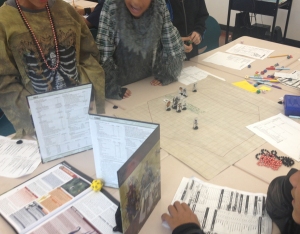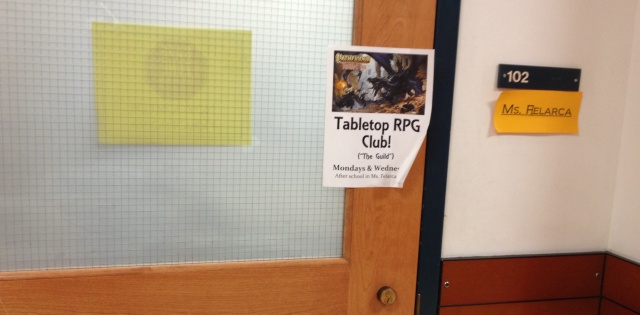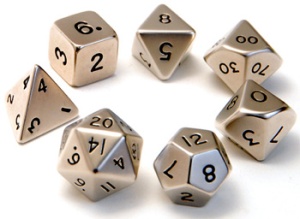 Yet another article on my musings while being the adult “Grandmaster” of a successful middle-school Pathfinder RPG club (now 50 students strong!) that the kids and I affectionately call “The Guild.” These posts likely will interest others who are introducing tabletop RPGs to young people. Read, comment, and enjoy!
Yet another article on my musings while being the adult “Grandmaster” of a successful middle-school Pathfinder RPG club (now 50 students strong!) that the kids and I affectionately call “The Guild.” These posts likely will interest others who are introducing tabletop RPGs to young people. Read, comment, and enjoy!
Although I have not racked up the number of articles I initially thought I would when I started this series of posts, I have been racking up plenty of experience. Nothing like two years of experience to give someone a better idea of how to run an afterschool program for middle schoolers to play tabletop roleplaying games.
Part of what has made me hesitate to write more on this topic, is the sheer volume of what I could potentially write. I could elaborate on questions and comments as they arise though, which can seed ideas for future posts.
So I suppose I should just start with an overview of the class and how it works.
The class meets twice a week after school. Each class is two hours long. (In spring 2014 it had grown to three hours long, but budget cuts forced us to scale back. We return to three hours in spring 2015.)
The first few things one notices upon visiting the class is that it is LOUD! On a typical day now, there are 30-35 kids at 6 tables playing simultaneously. I am the only adult in the room, and it is quite harrowing to have, constantly, 1-3 kids desperately asking me a questions.
When a student comes for the first time (usually introduced to me by their friend who already is in the class), I pair him or her with a veteran student to make their first character. I have one binder labeled “Classes” — it has pictures of all 31 iconics paired with a one-sentence blurb, and all the pictures are held in transparent plastic sleeves for durability and ease of viewing. A second binder is labeled “Races” and has selected pages from the Advanced Race Guide. I also give them a free printout of the Beginner Box Hero’s Handbook and a flyer that gives an overview of the class and Pathfinder RPG, points people to the class website, and asks parents to fill out their contact information.
Students earn XP — not their characters. Everyone starts at Level 1 and has 100 XP, which lets them make a Level 1 Pathfinder character. At Level 2, they can make a Level 2 character, and if that character dies they can replace it with another Level 2 character. Hence, XP serves as the prime mechanism to keep the class together and the kids behaved. Kids earn XP by making characters, playing in adventures, and they can earn bonus XP helping me with the class or GMing their own games. They get penalties for using a computer or their smartphone without permission, or for not cleaning up. I formalize all the rules for XP in the Guild Charter.
The kids tend to improvise and come up with their own wacky ideas.
I try not to discourage this or hamper their creativity, but just letting them do whatever they want can lead to abuse of GM fiat or player boredom. So I do my best to tutor young GMs to improve their skills, and I work with them between classes to put more thought and planning into their adventures and flag monster abilities for them that will come up. I do my best, though, to work with those few who are most committed to learn and providing a good experience by giving them prewritten Pathfinder modules to run in the class and working with them closely.
We have special events as well, most notably the Guild Tournament that happens at the end of each semester, in which students pair up to create Level 4 characters to battle each other in an arena I provide. If they win, they advance to the next round, where their characters are two levels higher. Each successive victory earns a larger reward of XP. This fall, for the first time, I held an Arena Design Contest, and the last two arenas designed by the kids themselves plus my changes.
Starting early in 2014, I used Pathfinder’s kingdom-building rules from Ultimate Campaign to place all the adventures that take place in the class in the fictional nation of “Gildhaven.” The various leadership roles are assumed by members of the class. The High Council gets word of problems that need solving, and assigns adventurers to go on missions or does some of the more-dangerous missions themselves. They also make decisions on constructing buildings, founding new settlements, expanding the nation’s territory, sending diplomatic envoys, and forming armies. In October, I had the kids form political parties and run for the positions on the High Council. The kids were very interested because I introduced the threat of war with a neighbor, and had a disease affect the whole class (everyone had to roll Fortitude saving throws) that the High Council had to solve. The older kids formed the Elder Party, and the seventh graders clustered around the Cthulhu Political Party and had to fend off accusations that they would summon a CR 30 creature to swallow Gildhaven. The Council has since raised an army, and are now in touch with a suspicious nation to the south, friendly orcs (and trading partners) in a mountain range to the north, and the exotic and prosperous nation Cheliax farther north still. Kids have started using their gold to construct their own homes and even their own businesses, and placed them on the kingdom map.
I now require most new students to go through the task of making their character sheets on paper along with a veteran buddy, so that they can get an overview of the game, get a sense of how the numbers interact and how to find things on their character sheet. But after that first sheet I port everything over to Hero Lab at home.
Each kid has a folder that I keep in portable metal hanging-file cabinets that they put everything in — their character sheet(s), any adventure(s) they are running, and a Ziploc bag that has their character pawn, a pawn base, and an initiative card (a folded, lengthwise-cut index card with the kid’s name that the GMs place on top of the GM screen to track initiative). I make sure to take home character sheets that have significant changes
I provide supplies for the class, which includes Chessex battle mats, wet-erase markers, pawns and pawn bases, and multiple printed spiral-bound printouts of the Core Rulebook and Bestiary, with single copies of the vast majority of other books in the Pathfinder core-rule and bestiary lines. I’ve required that kids bring their own dice to reduce the amount of dice left lying around for others to clean up. I also have printed Beginner Box Hero’s Handbooks and Game Master’s Guides to give kids to learn the game.
I have come up with rules for “Dungeon Defense,” which uses the basic concept of tower-defense games and combines them with the Pathfinder RPG rules. They form teams of four and take turns raiding a dungeon that the opposing team creates and populates. In doing so, I have tried to channel the spirit of competition in the class into situations where teamwork is required.
The response of the kids to the class has been phenomenal, and for nearly all of them I think it’s the high point of their day. When our class was three hours, a good core of students would stay the entire time to play the game or peruse the game books.
In January 2013, we faced the threat of cancellation. But the kids and their parents rallied and made sure that the class was continued. Since then, the class has grown steadily in size and popularity, from an average of 10 kids attending on any given day to now 32.
Playing games with their friends and being powerful heroes in a perilous world after school twice a week? The kids wouldn’t have it any other way.
===========================================================
Stay tuned and follow my “Grandmaster’s Guide” articles! I will post on whatever inspires me, which will range from general topics (e.g., middle-school students vs. high-school students) to lessons I learned from specific experiences (such as that First Day!). It amuses me, reading my original postings on the Paizo thread that gave birth to this series of articles, that I had a VERY different idea of how the class would play out, from what eventually would evolve out of the unpredictable insanity that would follow.







